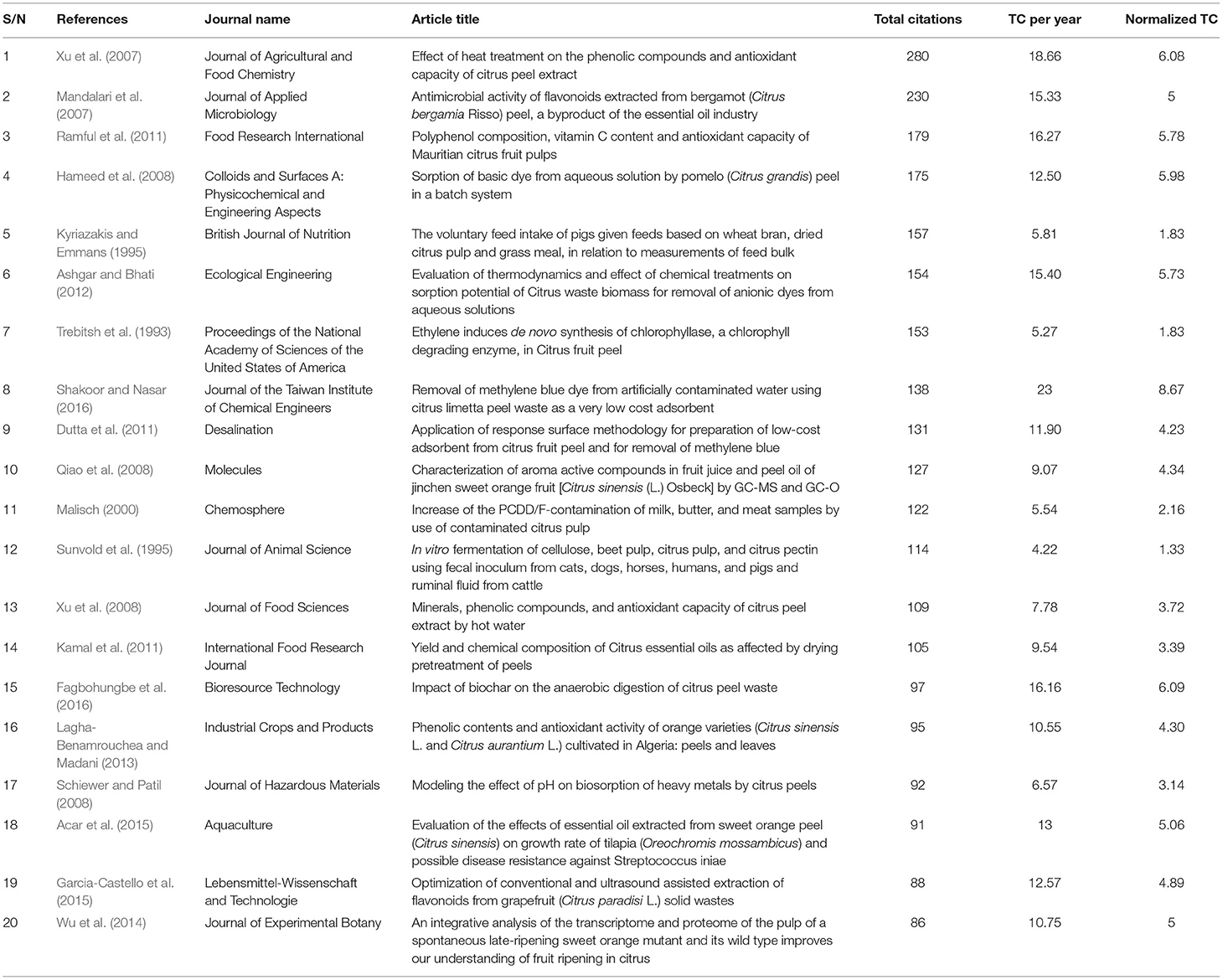- 1Small-Scale Agribusiness and Rural Non-farm Enterprise, Niche Area, Walter Sisulu University, Mthatha, South Africa
- 2Department of Economics and Business Sciences, Faculty of Commerce and Administration, Walter Sisulu University, Mthatha, South Africa
The present study aimed to reveal the abundant tapestry of research on citrus waste and livestock feed, taking into account the recurring challenges posed by feed shortage and high price of conventional animal feed in livestock farming. In total, 565 articles were retrieved in a BibTeX format for analysis using bibliometric package in R studio. The retrieved data included, but not restricted to authors, citations, keywords, journals, and institutions. Published outputs on citrus waste and animal feed for livestock production obtained from Scopus and web of science (WOS) databases were used in this study. The field of citrus waste and livestock feed research experienced an increase in terms of research outputs with an annual growth of 10.20% during the study period. Based on the country level, Brazil was rated first with an aggregate sum of publications (n = 81), with China having a huge global academic influence with most top article citations (n = 1,338). The topmost authors' keywords commonly used in the studied research area were citrus pulp (n = 48), pectin (n = 26), performance (n = 22), and citrus (n = 33), which created a hint on associated studies on citrus waste and livestock feed. The present study provides a global trend to traverse the intellectual quandary on citrus waste and livestock feed research, and guidance for further studies in this field. It is essential to stress that the present study only dealt with core areas of citrus waste and livestock feed research, hence, it is anticipated that new empirical research and prospective solutions would afford new knowledge insight on citrus waste and livestock feed as new studies evolve.
Introduction
Shortage of good quality livestock feeds required to sustain livestock production and performance, especially during drought or dry seasons has been reported to affect the advancement of animal production in most countries and especially in developing countries. Non-conventional feed resources including crop residues are in regular search to lower the over-reliance on conventional feedstuff resources and to reduce feeding costs during animal production. The moderately high prices of livestock feed in many countries are part of the identifiable challenges in animal production among others (Basir and Toghyani, 2017). Livestock feeding systems based on naturally abundant by-product feedstuffs (BPFs) are often a practical alternative for animals because their gut microbial ecosystem can utilize BPFs, which often contain high levels of structural fiber to meet their nutrient requirements for growth, maintenance, production, and reproduction performance (Bombik et al., 2002; Hernandez et al., 2004; Yang et al., 2009).
Wastes from fruits and/or vegetables produced in crop farms or those gotten after processing from agro-allied industries, are, however, well-endowed in some vital nutrients that have the potential to be supplemented in livestock diets as feedstuffs. The incorporation of fruits wastes in animal feeds has been found to enhance palatability of diet and consequently increase feed consumption in addition to decreasing the cost of the feed (Chaudry et al., 2004). Most livestock farmers of late fancy the use of alternative feedstuff resources which are proved to be nutritious and beneficial for their animals and have been certified to have no harmful effects for human consumption (Ellin-Doyle, 2001).
One of such naturally abundant fruit crops that can be explored in most countries globally as a feedstuff for livestock production is citrus (Pourhossein et al., 2015; Alnaimy et al., 2017; Seidavi et al., 2020). Citrus fruits are of various varieties, including lemons, limes, oranges, tangerines, and mandarins among others. The production of citrus is increasing day by day because of increasing consumer demands. Oranges, a part of citrus fruit accounts for more than 60% of the world's citrus production with ~82 million tons (Alnaimy et al., 2017). Citrus farms and citrus agro-allied processing industries generate huge amounts of citrus wastes yearly. According to Sharma et al. (2017), citrus peel waste alone gives rise to nearly 50% of the wet fruit mass. Citrus waste can be harvested globally on a massive and large scale of land giving rise to ~50–60% total of its production level and industrial significance (Satari and Karimi, 2018). Citrus fruit waste is of enormous economic worth as it contains plenty of various useful nutritional compounds, including carotenoids, flavonoids, dietary fiber, essential oils, sugars, polyphenols, and ascorbic acid, as well as substantial amounts of some trace elements, which can benefit livestock.
Furthermore, the citrus waste contains high levels of sugars suitable for fermentation for bioethanol production (Varmie and Mamta Thakur, 2021). It is well-established that citrus fruits and citrus products are rich sources of vitamins, minerals, and dietary fibers (non-starch polysaccharides) essential for the nutrition, growth, and overall development of animals (Economos and Clay, 1999; Varmie and Mamta Thakur, 2021). Recently, citrus fruits have been observed for other non-nutrient yet biologically active compounds such as flavonoids, carotenoids, vitamins, and minerals which could be medicinal for animals (Benavente-Garcia and Castillo, 2008).
Citrus waste is partly the unwanted/un-used materials (pulp, peels) obtained from farms and agro-allied industries after processing. However, the waste from citrus may cause several potential economic and environmental problems because of its fermentability if not properly converted to environmentally friendly value-added products (Tripodo et al., 2004). The current volume of citrus waste often gotten as by-products from citrus farms and other agro-allied processing industries could be useful in strengthening the nutritional gap experienced in animal feeds and further evading the age-long competition for edible grains consumption (e.g., maize) often created between human and livestock. Therefore, the utilization of citrus waste as animal feeds to advance livestock farming needs more attention. To the best of our knowledge, and based on the information that we can gather, no published article has analyzed scientific pieces of literature on scientometric studies on the current research trends on citrus waste as animal feed for livestock production.
In addition, there are several numbers of growing research outputs done globally at a fast pace and it is somewhat becoming almost impossible to remain up-to-date with everything that is being published about a particle subject matter at a glance (Briner and Denyer, 2012). Evaluating research documents on citrus waste as a potential animal feed resource for livestock is vital with such studies being carried out with the use of scientometric indicators that will further help to recognize hot, current, and trending research topics, country contribution, international collaboration, and research trends on the subject matter. Therefore, the present study was carried out to assess and analyze research outputs on citrus waste as feed for livestock production.
The procedure often adopted to assess and analyze scientific work done on a particular subject matter is referred to as scientometrics or bibliometrics, which is different from systematic evaluation and literature reviews. The foremost objective of the scientometric analysis is to analyze trends of research, main research themes, top-cited articles in the field, global, national, and local impact, scientific contributions, and vital actors in a particular field. Several top-notch scientific publications including the reports of Khatun and Ahmed (2011), Loomes and van Zanten (2013), and Ekundayo and Okoh (2018), have been carried out by utilizing the scientometric tools to evaluate precise research done in different fields of studies all over the world.
The present study was supported by a scientometric analysis sustained on the data existing in the databases traversed for this research. Additional statistical, data mapping methods, mathematical calculations, and procedures were also added to boost the results of this research work. Therefore, the key drive of this study was to assess the global trend of research outputs on livestock production advanced by the utilization of plant-based alternative resource (citrus waste), by analytically discussing the scholarly position in the production of livestock production using citrus waste, which presently is a growing interest globally and they are the two interconnecting areas of the present study.
Conversely, the present study reported several high-flying categories on the utilization of citrus waste for livestock production studies, for instance, authors, research outputs, distribution of countries, the global trends of citation, thematic evolution of authors' keywords, words, keywords, and trending topics on the subject matter. The outcomes from this study have a robust prospect of increasing the disciplinary knowledge bank of citrus waste as an alternative feed resource for livestock production. By exploring outputs on scholarly high-flying work, this study will help in recognizing areas of potential research gaps and research dynamics on citrus waste and livestock production globally. Furthermore, we are optimistic that this study will be valuable to research experts, livestock industry, and other stakeholders in this field. The study will also help to advance and explore scientific studies done in livestock production and propose probable future research prospects.
Materials and Methods
Definitions of Analyzed Data Terms
The analysis package (Bibliometrix) that was used for this study is a suitable tool known for precise/accurate package employed for processing data from articles/publications including file conversion, duplicate matching and merging, similarity normalization for network analysis, descriptive analysis term extraction, and matrix building (Aria and Cuccurullo, 2017). The data matrices used were built from research article datasets, such as words, authors, countries, keywords, and references for outputs such as cocitation, coupling, collaboration, multiple correspondences, and conceptual framework analyses. The bibliometric graphical coupling happens between two (2) research articles of say “a and b” that had their reference lists mentioned/cited from at least one common source (Ekundayo and Okoh, 2018). The aggregate number of bibliographical coupling that ensues between research articles “a and b” or co-authorship in networking and scientific collaboration denotes the strength of the network (Aria and Cuccurullo, 2017). A specific network represents relationships in a classification/system as a group of nodes and links (Zhang et al., 2012). Meanwhile, the conceptual framework assessment uses the K-means grouping/clustering and other measurement techniques to categorize clusters/groups of shared concepts recognized in bibliographic groupings/collections. This K-means depends on word co-occurrences in a research output/publication dataset (Aria and Cuccurullo, 2017). Furthermore, scientific output or a researcher's contributions/influences in a research niche area (field) is analyzed based on Lotka's law. This law can be said to be an inverse square law, which defines how often researchers produce articles in their niche area/field (Lotka, 1926).
Retrieval of Data Used for Analysis
The present study made use of published scientific documents on citrus waste linked with livestock production research outputs, and they were obtained from the combination of Scopus and Web of Science (WOS) archive on 15 July 2021. Scopus and WOS databases hosted reliable and efficient high-impact scientific publications (Mansoori, 2018; Repiso et al., 2018; Orimoloye et al., 2020). Hence, the current study made use of Scopus and WOS to gather data for the proposed objective. The advanced search function in Scopus and WOS was used because both databases allow for building long and composite search queries. Ordinarily, in research publications that involve scientometric review, one database can be utilized because scientometric indices and literature mapping are hard to perform on articles retrieved from more than one different database (Sweileh, 2020a,b). Conversely, it has been reported that using only one database for information retrieval may limit the inclusion of some significant articles that may be needed for analysis on a particular subject matter (Mansoori, 2018; Orimoloye et al., 2020). The use of Scopus and WOS databases will guarantee 100% inclusion of PubMed. Therefore, Scopus and WOS are guaranteed to have an all-inclusive collection of articles in PubMed and other scientific databases.
Search Strategy Used for Data Collection
For us to successfully create a search query that is appropriate to collect most of the associated volume of research publications with the slightest false-positive outcome, we embarked on an exhaustive literature review research on the subject matter/topic, and principally on studies and systematic reviews to acquaint ourselves with most of the likely keywords related to the search topic. This method of search strategy for data collection has also been used by several other authors in other research fields (Milan et al., 2013; Mukhopadhyay, 2014; King et al., 2018; Fesseha et al., 2020). The modest technique that we adopted in the search for data collection was to use the title/abstract search methodology for keywords related to “citrus waste” and “livestock.” Howbeit, adopting such a strategy may lead to the retrieval of a huge number of documents that may not be useful for our study. Therefore, to streamline the title/abstract method that was used, a particular constraint was employed that included the presence of certain “terms” related to citrus waste or livestock production in addition to the title/abstract strategy.
Search Query Employed for Data Collection for This Study
The search query used for the present study comprised of specific phrases related to citrus waste with precise phrases related to livestock production which were entered into the title/abstract search engine. This was followed by some specific terms as a restriction to lessen and remove irrelevant research publications that are not part of the objective of the study. The search queries that we used for WOS and Scopus are given below.
1. Scopus
578 document results(TITLE (citrus* AND (waste* OR feed* OR peel* OR pulp))) AND (ruminant* OR livestock OR poultry OR sheep OR goat* OR rumen OR broiler* OR pig* OR swine OR turkey) AND (LIMIT-TO (DOCTYPE, “ar”)).
2. Web of Science
187 results from Web of Science Core Collection for:citrus* AND (waste* OR feed* OR peel* OR pulp) (Title)Refined By: Search within all fields: Ruminant* Or Livestock Or Poultry Or Sheep Or Goat* Or Rumen Or Broiler* Or Pig* Or Swine Or Turkey
Document Types: Articles Clear all.
Analysis and Processing of Data
The current study analyzed all collected data from Scopus and WOS databases by using RStudio v. 4.0.4 software with bibliometrix R-package for scientometric elements (Aria and Cuccurullo, 2017). All retrieved data were then imported into R Studio and refined into a bibliographic data form before they were structured to remove duplications that may arise from the two databases (Scopus and WOS) that were used (Ekundayo and Okoh, 2018). Before processing the data, the removal of stop words that are not relevant to the current study was also carried out. Likewise, similar concepts of terms were normalized before analyzing the data. A graphic representation of the retrieval and analysis of data is given in Figure 1. To avoid article duplication extracted from the two databases, all replicated peer-reviewed articles were restricted to one record in the analysis. Furthermore, for visualization, the names of authors, author's keywords (DE), and keywords plus (ID) were extracted. All retrieved data were reviewed for variant names, spelling errors, and associations. For keywords (DE) and keywords-plus (ID), the subject of the present study (citrus waste and animal feed) was given a primary term to terms. Furthermore, the co-occurrence of a phrase in the keywords (DE set) and keywords-plus (ID set) of authors in the dataset was assessed as a group made of the two sets (DE and ID) that converge.
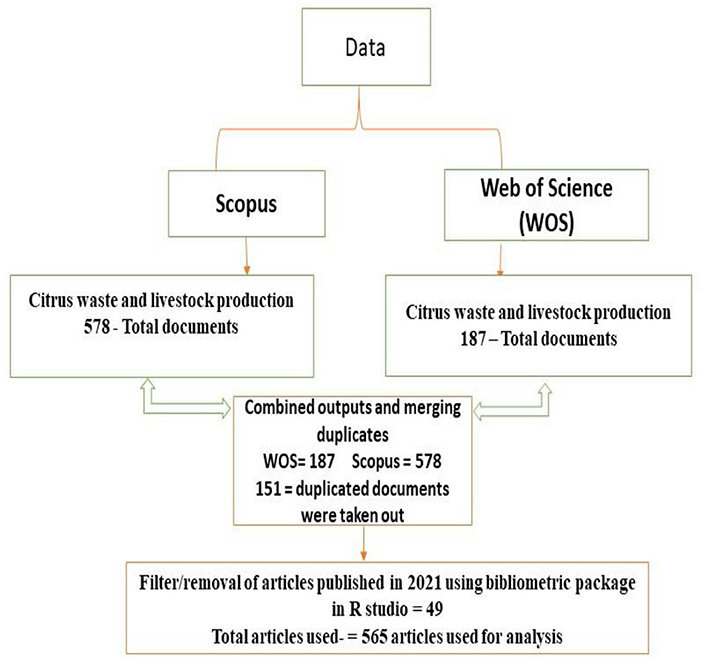
Figure 1. Diagrammatic representation showing the inclusion and exclusion criteria for out-puts selection.
In addition, we employed necessary commands/functions of bibliometrix R-package to analyzed retrieved data for the following descriptive result, citation assessment, authors' scientific performance/productivity. Bibliometric scientific collaboration and networks (e.g., citation, author keyword, and keywords-plus, author, nation links) and bibliometric graphical coupling (keyword co-occurrences and co-citation) were calculated and visualized from bibliometric bipartite (two-way) collaborations/networks of rectangular yardsticks/matrices of research articles × attributes/traits. For instance, the formula for a characteristic bibliometric connection/network is given as Network (N) = X × NT;
Where X is a bipartite/biclustering (two-way) network matrix consisting of research articles × attribute/traits (e.g., nations, authors, citations, and keywords).
N is a dimensional/symmetrical matrix N = NT.
Likewise, a graphical model was created for all collaborations/networks by utilizing the force-directed algorithms (Fruchterman) applied in the networkPlot command/function of the bibliometrix R-package. Consequently, all the collaborations/networks were normalized/standardized by utilizing Salton's cosine coefficient, proximity indices (association strength), Simpson's coefficient (inclusion indices), and Jaccard's similarity indices among nodes of a network (Aria and Cuccurullo, 2017). In addition, the k-means groupings/clustering were performed on keywords to evaluate concepts in citrus waste as livestock food research field by utilizing the function of a conceptual framework of the bibliometrix R-package software. This function employed Porter's restricting/stemming algorithm (Porter, 1980) to moderately adjusted words to their exact/root form.
Results
From our results, 565 articles were published between the year 1961 to 2020 of the study period; the analysis features are presented in Table 1. The outputs for the surveyed periods comprise 2,069 authors, with 8 single author, 0.273 articles per author (3.66 authors per article), a collaboration index of 3.71 and 4.88 co-authors per article. With the exemption of eight authors who were single authors, all other authors (2,061) had multi-author research outputs. An average of 17.26 citations per article was documented during the study period. Likewise, Figure 2 shows publications of global mappings associated with citrus waste and animal feed research for livestock production for the top 20 most active nations (based on corresponding authors' countries). Among the five most productive nations, Brazil ranked first in aggregate numbers of articles (n = 81), followed by China (n = 55), India (n = 39), Turkey (n = 38), and Korea (n= 34), respectively, among other nations. In Figure 3, the present result showed a trend in research outputs on citrus waste and animal feed for livestock production with an annual growth rate of 10.20% (Figure 3). From the values in Figure 3, it can be seen that there were several fluctuations (downward and upward trends) in research outputs between 1961 and 2005 during the studied period; however, there appears to be a steady growth after 2005 till date (Figure 3). The peak year of article publication in citrus waste and animal feed production research field was in the year 2020 with a total output of 59 articles (Figure 3). The average article citations (AAC) of most cited countries in the field of citrus waste and animal feed research for livestock feed showed that Mauritius (n =179), United Kingdom (n = 118), Israel (n = 52.80), and Germany (n = 50.66) lead the chart, respectively (Table 2). Publication outputs related to citrus waste and animal feed research for livestock production for the top 20 most active countries are shown in Table 3. Brazil is rated first in terms of the aggregate number of articles published (n = 81), the next country was China (n = 55), followed by India (n = 39) and Turkey (n = 38) among others, respectively. The frequency of research outputs varied among the top 20 nations from 0.00951 to 0.15399. Furthermore, the nations that topped the chart with multiple country publications and networking include Italy which is placed in the first position (n = 5), Brazil, Korea, and Iran which are tied in the second position (n =3), then followed by China and Egypt (n = 2), which are tied in the third position, respectively. Conversely, the nations ranked in top positions for single country publication of research outputs in the field of citrus waste and animal feed research for livestock production are Brazil (n = 78), China (n = 53), India (n = 38), Turkey (n = 37), and Korea (n = 31) among others (Table 3).
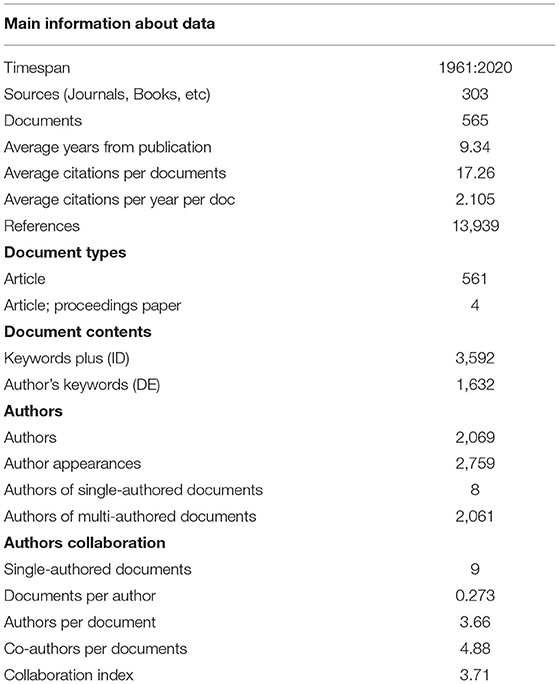
Table 1. General information of retrieved published documents on citrus waste as animal feed for livestock production from Scopus and WOS data bases.
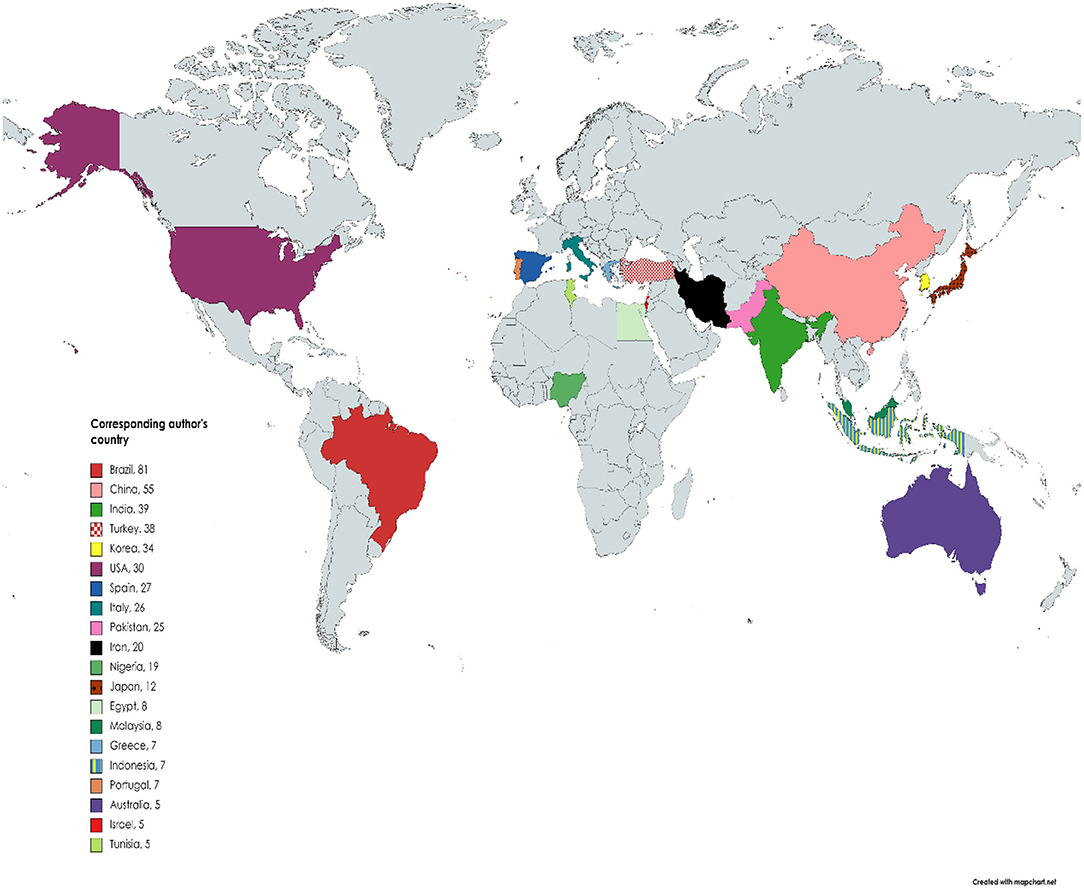
Figure 2. Spatial mapping of the top 20 most productive nations based on number of research articles on citrus waste and animal feed studies (Corresponding author's countries). Gray color areas depict the zones that are not among the top 20 nations.
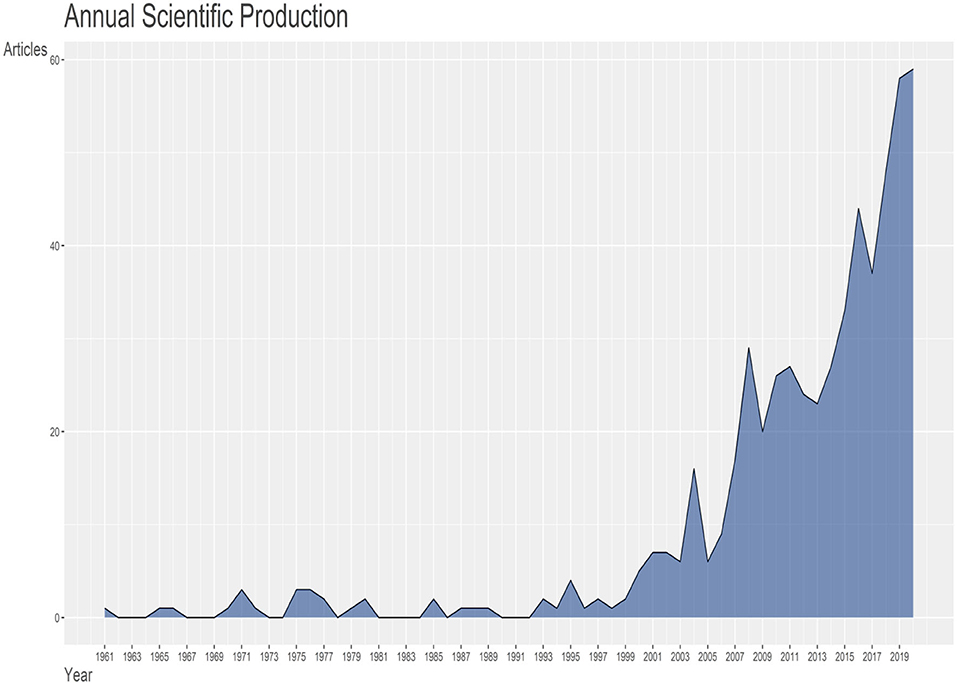
Figure 3. Trends of annual scientific publications (from 1961 to 2020) in citrus waste and animal feed research with an annual growth rate of 10.20%. Citrus waste and animal feed research studies showed several fluctuations (downward and upward trends) in research outputs between 1961 and 2005.
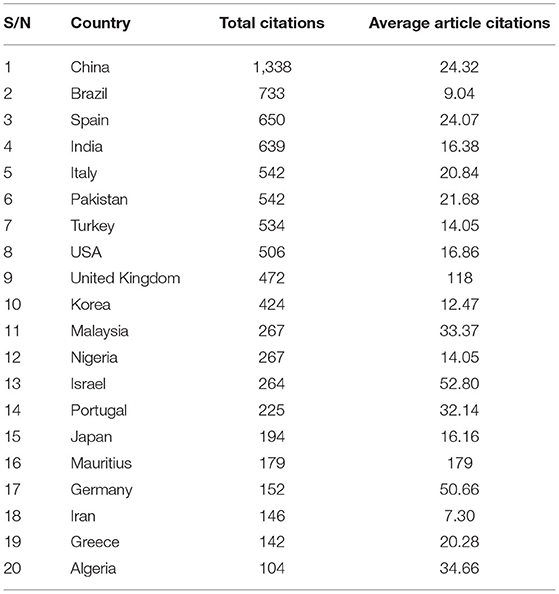
Table 2. The top 20 most cited countries in terms of average article citations (AAC) in the field of citrus waste as animal feed for livestock production from 1961 to 2020.
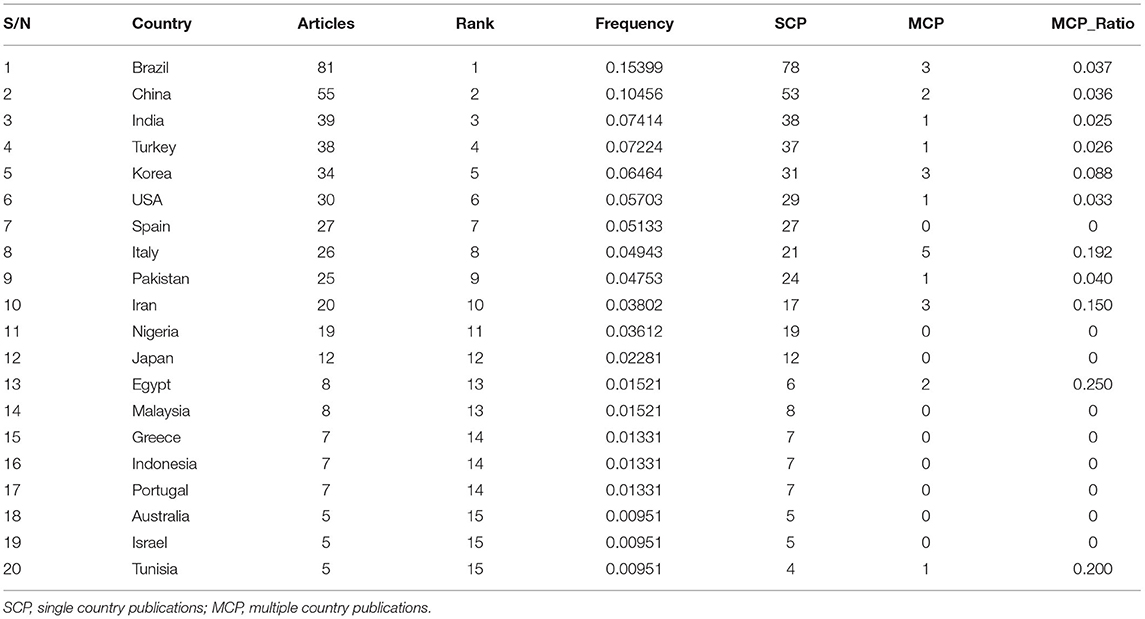
Table 3. The top 20 publications by countries in the field of citrus waste and animal feed production for livestock research.
Among the most relevant author keywords in the field of citrus waste and animal feed, citrus pulp (n = 48) was ranked first, followed by citrus (n = 32), performance (n = 23), and pectin (n = 22), among other keywords used by authors (Table 4). Furthermore, in Table 5, the top 20 most relevant/productive authors in the field of citrus waste and animal feed were reported. The author A, Pires was placed in the first position (n = 14) based on the number of articles; while I, Susin was ranked in the second position (n = 13), meanwhile G, Rodrigues was placed in the third position. Two authors, namely, R, Gentil and U, Ruiz, however, maintained the fourth position with 10 article publications each. Based on total citations, the H_index was 6 (TC = 140) for A, Pires who maintained the first position. However, author I, Susin was in the second position with H_index of 6 (TC = 151). The third position was maintained by G, Rodrigues with H_index of 4 (TC = 142).
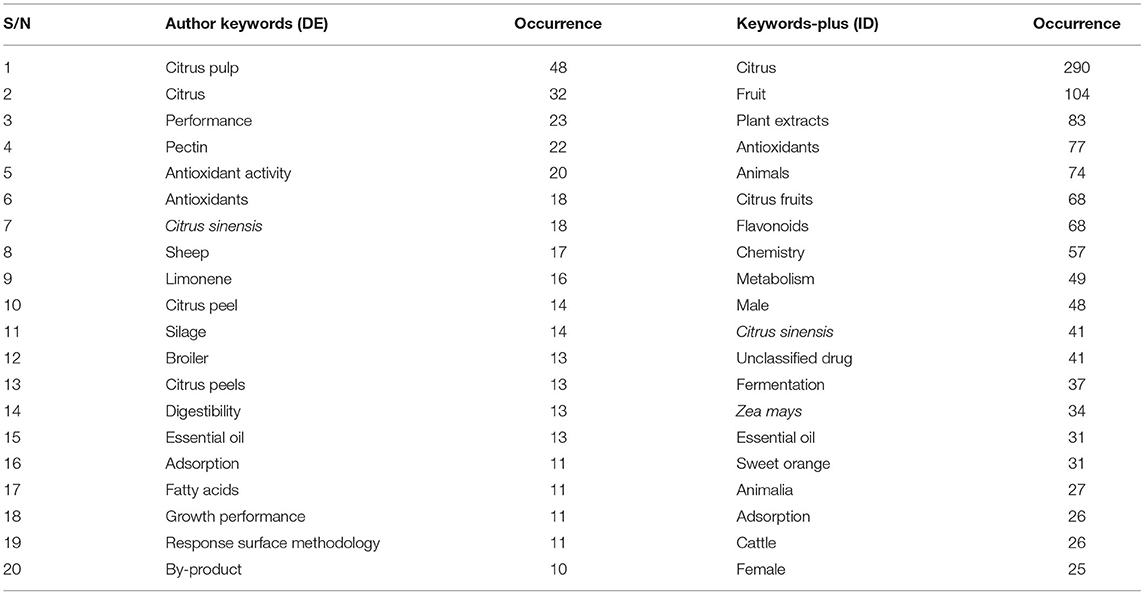
Table 4. Most relevant words used by researchers in the field of citrus waste and animal feed production.
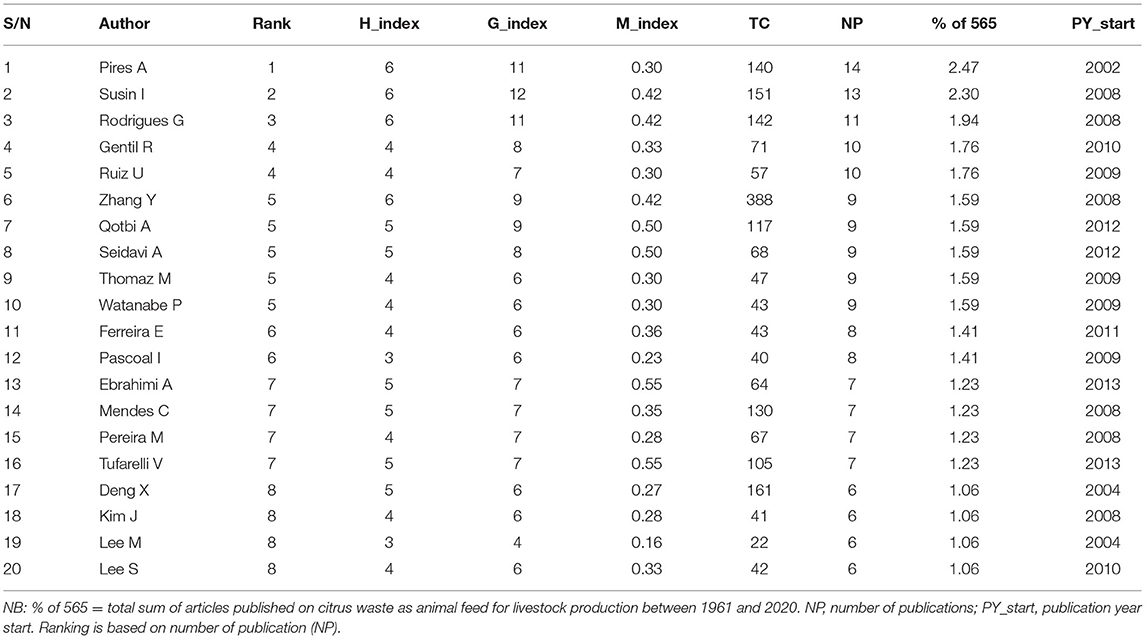
Table 5. Top 20 relevant/productive authors on citrus waste and animal feed for livestock production.
The shared conceptual frame maps of retrieved publications of citrus waste between 1961 and 2020 by factorial multiple correspondence revealed five clusters of sizes 10, 9, 5, 3, and 2 with research component focusing on citrus waste as animal feed, for livestock (e.g., cattle), to improve livestock performance (growth and digestibility), as feed supplements to maize (Zea mays), as alternative feedstuffs (citrus fruits, peels, and others) and as medicinal plants (antioxidant activities, flavonoid) for improving livestock performance and metabolism (Figure 4). The clusters explained the type of livestock animal commonly fed with citrus waste (cattle and other livestock, including sheep, goat, and chicken), and how citrus waste can be used as feed, that is, as a supplement to maize meal (Z. mays) or as a processed feed meal (citrus fruit or citrus peels). The orange cluster showed citrus waste as food for cattle. The purple cluster showed the use of citrus waste as a supplement with maize while the red cluster indicated the parts (citrus fruits, citrus peels, and others) of citrus waste that can be used for livestock feed to improve digestibility and growth of livestock. The blue cluster showed the utilization of citrus waste as medicinal plants (antioxidant), whereas the green cluster revealed the potential of citrus waste for improving animal metabolism (Figure 4).
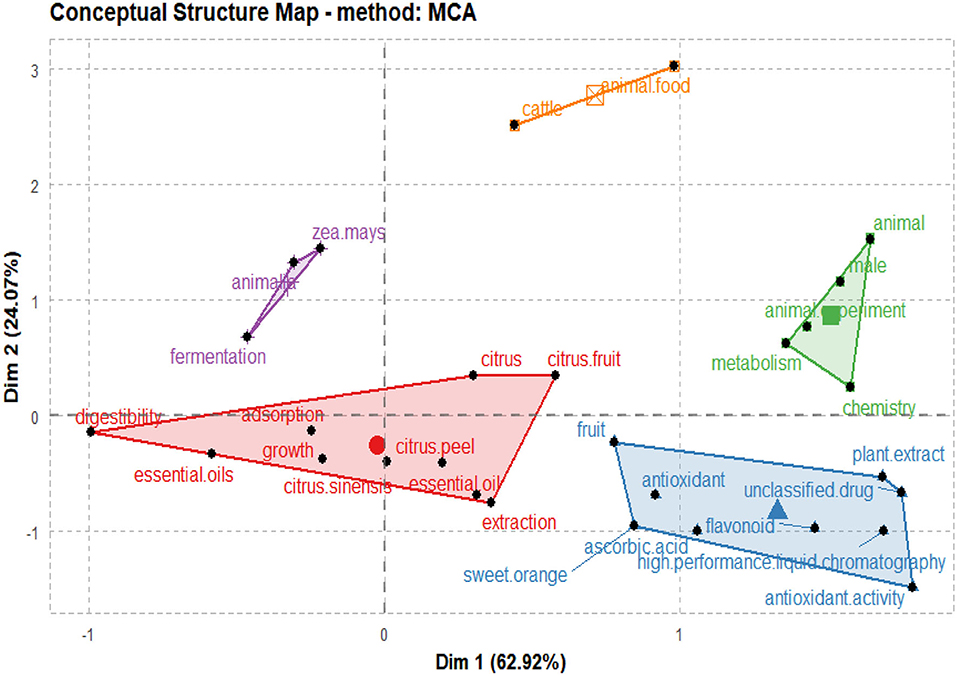
Figure 4. Shared conceptual structural map associated with citrus waste and livestock feed research studies (1961–2020).
Table 6 shows the top 20 most cited articles on citrus waste and animal feed based on total citations from 1961 to 2020. The article written by Xu et al. (2007) was ranked in the first position with a total of 280 citations. The article placed in the second position was authored by Mandalari (2007) with a total of 230 citations. The third and fourth positions had D, Ramful (TC = 199) and B. H. Hameed (TC = 175), respectively (Table 6).
The top 20 journals with the most published articles in the field of citrus waste and animal feed research for livestock production are listed in Table 7. These journals cover a range of fields, including citrus as medicinal plants (antioxidant activities, essential oils, plant extracts, liquid chromatography) chemistry, and livestock production (growth, digestibility, high performance), among others. Journals such as Revista Brasileira de Zootecnia, Arquivo Brasileiro de Medicina Veterinaria E Zootecnia, Journal of Agricultural and Food Chemistry, Revista Brasileira de Zootecnia [Brazilian Journal of Animal Science], Journal of Animal Science Journal of Dairy Science reflect active areas in citrus waste and animal feed research. However, the journal Revista Brasileira de Zootecnia ranked first (number of publications = 23; H_index = 10) among the journals with the most published articles. This was followed by Arquivo Brasileiro de Medicina Veterinaria E Zootecnia (number of publications = 15; H_index = 4). The Journal of Agricultural and Food Chemistry and Revista Brasileira de Zootecnia [Brazilian Journal of Animal Science] were ranked in the third position with the number of publications being 11 each and H_index being 9 and 7, respectively. Conversely, the Journal of Animal Science was ranked in the fourth position among the journals with the most published articles (Table 7).
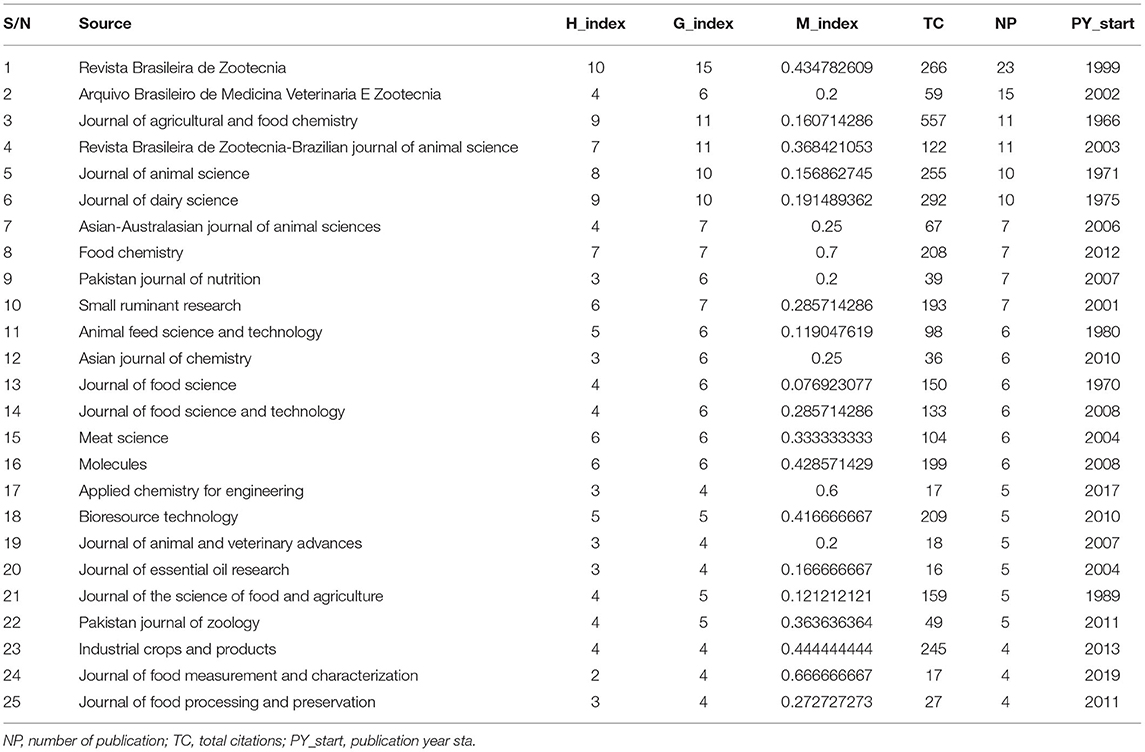
Table 7. The top 25 journals that are relevant in the field of citrus waste and animal feed research from 1961 to 2020.
From statistical assessment of the articles related to the use of citrus waste for animal feed production revealed that we can deduce that animal feed produced from citrus waste for livestock farming involves several research directions, including Animal Husbandry (such as cattle and sheep farming), Chemistry (antioxidants, adsorption, extraction), and Medicinal Botany (extracts, animal experiment), among others. The current study presents a better motivation for the advancement and a large space for research in the field of citrus waste recovery and animal feed (Figure 5). Furthermore, Figure 6 shows a network visualization map of nations' collaboration, depicting 30 countries that are involved with citrus waste as animal feed. Each node in the network is an individual nation and the diameter of the node corresponds to the number of publications by each nation. The strokes/lines denote the paths of networking between nations and the thickness of strokes/lines signifies the degree of collaboration between the nations. Collaboration links ranged from 1 to 20. Italy had a high number of collaborations (n = 20), followed by the United States (n = 19), and Iran (n = 13). However, collaboration links for developing countries such as Egypt, Nigeria, and Indonesia had very few links/networks compared to those from developed countries.
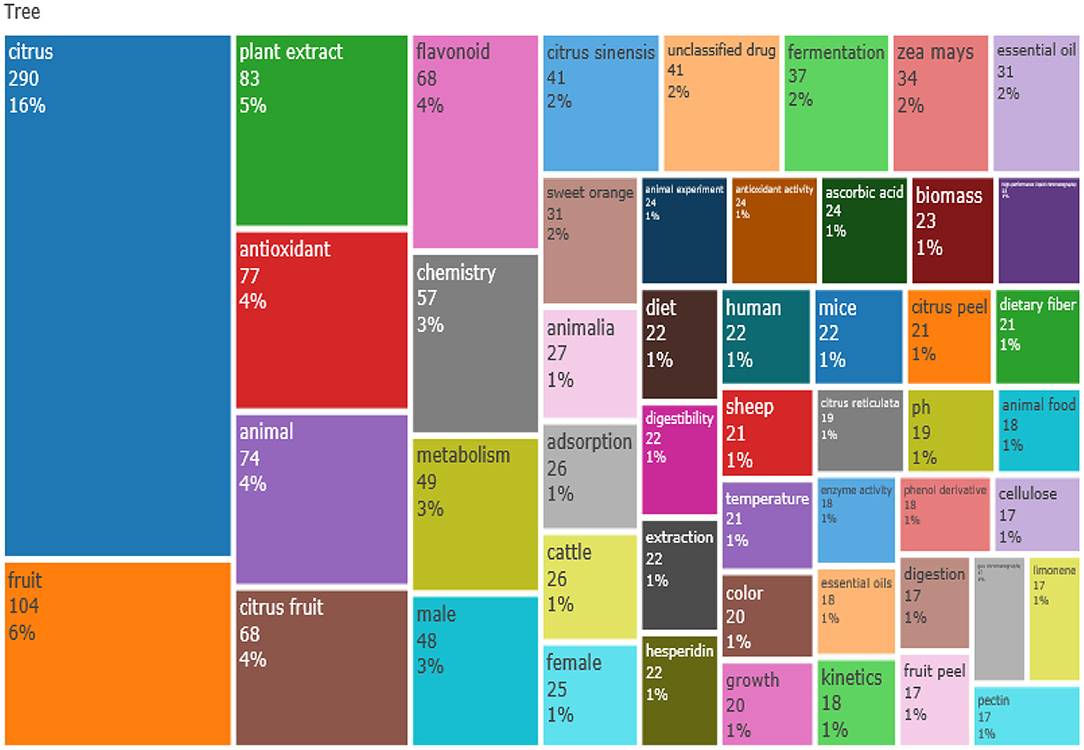
Figure 5. Tree map of discipline distribution in the field citrus waste and livestock feed research.
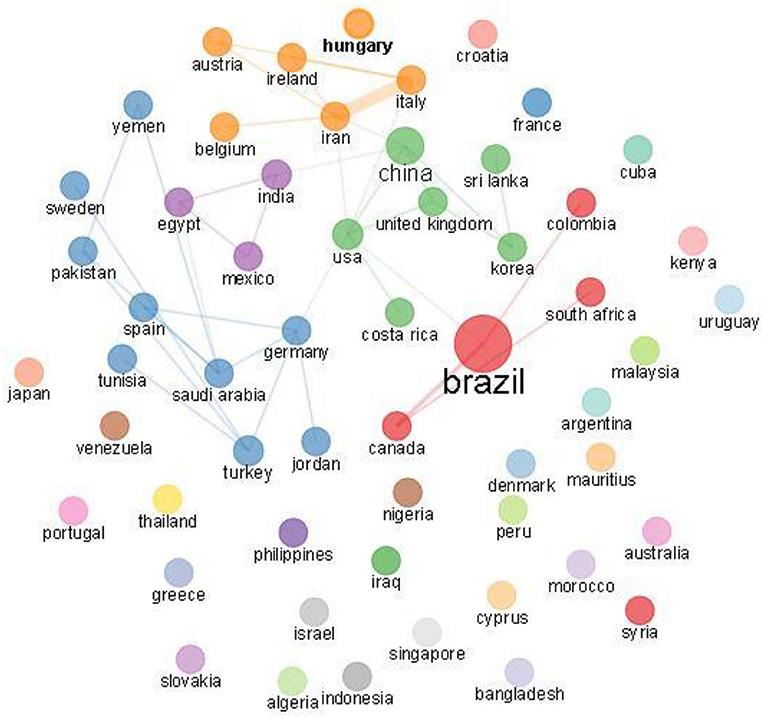
Figure 6. Thirty nations' collaboration networks on research out-puts on citrus waste and animal feed from 1961 to 2020.
The top 10 most prolific institutions with at least 10 publications are listed in Table 8. The Islamic Azad University in Iran (number of articles = 31) was ranked first; University of Agriculture in Pakistan (number of articles = 23) was ranked second, and the University of São Paulo in Brazil (number of articles = 15) was ranked the third position, respectively, among others. Conversely, from the 10 most prolific institutions that were ranked, two of the institutions (University of São Paulo and Universidade De São Paulo) were from the same country, that is, Brazil (third and eighth position), while another country, Turkey had two institutions (Istanbul University and Canakkale Onsekiz Mart University) in the fifth and eighth positions of most prolific institutions (Table 8).
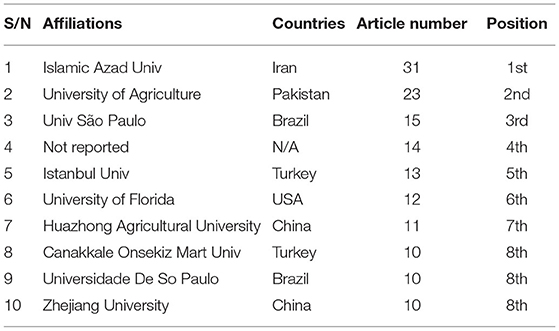
Table 8. The top 10 most productive institutes on citrus waste and animal feed for livestock production with at 10 article publications.
Discussion
The current study of citrus waste and animal feed for livestock production examined global research trends between 1961 and 2020 based on data collected from Scopus and WoS. We observed that the number of publications on citrus waste and animal feed for livestock production increased non-linearly from one article in 1961 to 565 articles in 2020. Conversely, there were fluctuations in research outputs on citrus waste and animal feeds from 1961 to 2009. These fluctuations, however, experienced a steady rate of increase which was observed from 2005 (n = 6) to 2020 (n = 59) resulting in an annual increase of 10.20% of article publications. The increase in research on citrus waste and animal feed suggests that more researchers have now developed more interest in this area in the past 15 years. This trend may likely be a result of the continual exploration of plant-based alternative feed resources to advance the search for cheaper and helpful animal feed for livestock production. Several authors have reported the prospects of using citrus waste (pulp) as animal feed to improve milk yield in cattle (Malisch, 2000), feed intake in pigs (Kyriazakis and Emmans, 1995), the growth rate in fish (Acar et al., 2015), and to promote growth performance, intestinal morphology, humoral immunity, and egg quality in poultry (Nazok et al., 2010; Basir and Toghyani, 2017; Seidavi et al., 2020). Furthermore, from the annual scientific production graph in Figure 3 (with an annual increase of 10.20%), there is a strong indication that more scientific outputs on the use of citrus for animal feed will further increase in the future. Although it seems that the utilization of citrus/citrus waste as animal feed in Agriculture has not been fully exploited, citrus waste (peels or pulp or essential oils) has been used in other fields such as Chemistry, Medicinal plant, and Botany among others (Kamal et al., 2011; Ramful et al., 2011; Lagha-Benamrouchea and Madani, 2013). Its successful application in the field of Botany, Chemistry, and Medicinal plants is an indication of its novel potential for animal feed and livestock production. With the ever-growing challenge of price increase in conventional animal feed and sometimes scarcity in obtaining animal feed for livestock production in some countries, and especially in developing countries, this may further drive the present generation of new scientific knowledge, toward a significant rise in the number of research studies that will be done on this subject matter.
As with other research areas, it was observed in the current study that most of the leading authors driving the use of citrus waste (peel, pulp, leaves) as an alternative animal feed resource for livestock production were mostly from developed countries such as China, Brazil, the United States, Korea, and Turkey, with a few from very low-income countries (such as Nigeria and Egypt), thus follow the associated trend of low productivity of these countries. The foremost countries with collaboration links on citrus waste and animal feed research studies showed a collaboration allied was mostly among researchers from developed and highly financially stable countries, including the United States and Italy. This observation appears to be a similar trend for collaboration networks of countries in many other research fields (Orimoloye and Ololade, 2021; Smith et al., 2021). A common trend in bibliometric studies shows that alliances between developed and developing countries are scarce in several scientific fields (Ekundayo and Okoh, 2018; Orimoloye and Ololade, 2021). Collaboration in scientific research from both intra- and international institutions between developing and developed countries could foster more robust opportunities for pulling resources (funds and facilities) and more manpower for division of labor to tackle important research gaps in the field of citrus waste and animal feed research.
According to Zhang et al. (2010) and Peng et al. (2015), the economic strength/prowess of a certain nation motivates their research priority and productivity. The situation of food insecurity, sustainability, and increase in price of conventional animal feed in most developing countries, and mostly in countries from sub-Saharan Africa should spark up more drive in researchers in these countries to explore the prospect of doing more studies on the use of citrus and/or waste as animal feed for livestock production.
Several parts of citrus waste (including peel and pulp) are known to be high in lingo-cellulosic substances, which are reported to be a rich source of compounds for the production of new and sustainable chemicals and fuels (Ranzi et al., 2008). Furthermore, several scientists have reported the use of citrus waste (valorization techniques) for biofuels through the process of gasification, thermolysis, combustion, and pyrolysis (Miranda et al., 2009; Zapata et al., 2009; Kim et al., 2015; Volpea et al., 2015; Alvarez et al., 2018). More research studies geared toward exploring innovative ways of adopting the use of citrus waste for animal feed can, however, not be over-emphasized. According to Chavan et al. (2018), waste from citrus fruits is a very essential resource material that can be utilized to boost the global food systems both in the area of farming and in the industrial sectors.
In Table 6, it was observed that, some of the most frequently cited articles were studies associated with the utilization of citrus waste (peel, pulp, and others) as an alternative feed resource for improving livestock production such as milk yield, growth performance, immunity booster, and feed intake in different farm animals (cow, pig, fish, poultry) among others. For example, some articles reported the use of citrus parts (such as peels, pulps) as waste to
(i) Increase the PCDD/F-contamination of milk, butter, and meat samples by use of contaminated citrus pulp (article by Malisch, 2000).
(ii) The voluntary feed intake of pigs given feeds based on wheat bran, dried citrus pulp, and grass meal, in relation to measurements of feed bulk (article by Kyriazakis and Emmans, 1995).
(iii) Evaluation of the effects of essential oil extracted from sweet orange peel (Citrus sinensis) on the growth rate of tilapia (Oreochromis mossambicus), and possible disease resistance against Streptococcus iniae (article by Acar et al., 2015) were among other excellent articles that were frequently cited in this research field.
Conversely, it can be observed as seen in Table 6 that, other authors focused on the medicinal potential of citrus waste (peel, leaves, and pulp) as a functional food for animals and as antimicrobial and antioxidant agents (articles by Mandalari et al., 2007; Lagha-Benamrouchea and Madani, 2013). These novel research outputs are a pointer to the many other value addition prospects that can be derived in the use of citrus (pulp, peels, waste, leaves) as an essential alternative plant resource in the farming and food industry. According to Chavan et al. (2018), solid waste obtained from citrus is a good source of rich alternative plant-based sources that can be used as ingredients for livestock feed. In addition, Moreira et al. (2004) reported that as a very cheap and easy way of disposal for most industries and crop farms worldwide, that is, citrus waste is converted (in fresh or dried form) into animal feed for boosting livestock production.
China, Brazil, and India occupied the foremost positions among the top 20 nations that are in active research in the use of citrus waste as animal feed in terms of number of articles and citations among others (Tables 2, 3). One major reason for any country to fall within the category of more number of article production and citations in a given field may be attributed to the nations' economic strength and access to research facilities and funding (Liu et al., 2013; Peng et al., 2015; Zyoud, 2017). In addition, the increased productivity by foremost nations in this field could be attributed to the fact that China, Brazil, and India are known to be the largest producers of citrus fruits globally with a production yield of 44.1, 19.7, and 14.0 (million tons) of the plant (Knoema, 2019). However, although, the United States has always shown dominance in most research fields (Bundschuh et al., 2013; Geaney et al., 2015; Bruggmann et al., 2017), in the current study, the United States maintained the sixth position, judging from the list of top 20 most published articles in citrus waste and animal feed research (Table 3). The reason for the drop in position for the United States among the nations that had more article outputs is not known. However, the United States is reported to be ranked as the fifth largest producing country in terms of citrus fruit production (Knoema, 2019). This may be a contributing factor to their ranking in terms of article outputs in citrus waste and animal feed research.
Conversely, there is a relatively low contribution to research outputs on citrus waste and animal feed studies by developing countries including countries from Africa (with only Nigeria, Egypt, and Tunisia making the list in the top 20 countries) as observed from the present study (Table 3). This observation may not be unrelated to the fact that most research works done in these countries are often independent studies or self-funded which do not attract research funding from their government or non-governmental organizations.
There are very few observed situations of countries with multiple collaborations (multiple country publications) on citrus waste and animal feed research with Italy having the highest occurrence of multiple collaborations (n = 5) as seen in Table 3. Most countries in the list of top 20 most productive countries do not have collaborations (Table 3). This may not be unconnected to the fact that the present field (citrus waste as animal feed for livestock production) seems new, but it is gradually gaining recognition globally with an annual growth rate of 10.20% (Figure 3). However, from our observation, it is expected that more countries may likely get involved in multiple country collaborations judging from the current annual growth rate of research outputs being produced in recent years in this field. Collaboration in scientific research from both intra- and international institutions between developing and developed countries will bring about more robust opportunities for pulling resources (funds and facilities) and more manpower for division of labor to tackle vital research gaps in the area of citrus waste and animal feed for livestock production research.
Likewise, it was noticed from the current study that there was a swing in the rankings among the top 20 countries who were most active in the field of citrus waste and animal feed research when outputs were assessed using the criteria of total citations (TC) per nation (Figure 2 and Table 2). A similar observation was also reported in another scientometric study (Ekundayo and Okoh, 2018). The explanation for this unexpected swing in rankings when using the total number of citations to judge the publication outputs of a nation or an author may indicate its unreliability as an accurate measure for productivity. The rate of citations does not reflect the publication outputs of a nation or an author (Fricke et al., 2013). This is because, according to Fricke et al. (2013), the smaller the number of articles used for valuation, the greater the impact of a few regularly cited articles. In several cases, some researchers have been noticed to engage in self-citations, while others give inaccurate citations when writing their manuscripts which in turn may produce false qualitative and quantitative metrics of total citations about a particular author or country (Ekundayo and Okoh, 2018).
As envisaged, the present study provided some hints of the recent research hotspots in the field of citrus waste and livestock feed for the study period. A co-word biclustering (two-way) evaluation was done to reveal the scientific research hotspots in the niche area, where there were five clusters representing the hotspots, respectively. From the k-means analysis, the most regularly focused hotspot research and research disciplines (including article outlets) associated with citrus waste and animal feed study revealed the research hotspot during the surveyed period which included citrus waste (including citrus peels, citrus fruits such as sweet orange, C. sinensis) utilized to formulate food for improvement of livestock (e.g., cattle, animal food), citrus medicinal potentials (antioxidant activities, essential oils, plant extracts, liquid chromatography, chemistry), and the effect of citrus waste feed on livestock performance (growth, digestibility, high performance), which are commonly linked to citrus waste and animal feed research. The hotspot focus for citrus waste and animal field span through some disciplines such as animal feed nutrition, chemistry, bio-medicinal research, among others (such animal physiology, microbiology, and botany research).
Some topics, such as digestibility, growth, citrus fruits, citrus peels, adsorption, and essential oils have often been interesting for scientists/researchers. Sweet orange, C. sinesis and citrus peels and fruits seem to be the parts of “citrus waste” that have been consistently reported to be used for livestock feed. Specifically, research on antioxidants, flavonoids, ascorbic acids, and antioxidant activities has become a hotspot, probably because of the potential of the citrus peel to be used as feed, as well as for medicinal purposes in livestock production (Benavente-Garcia and Castillo, 2008). Meanwhile, metabolism and chemistry seem to be new foci among the research field of citrus waste and livestock feed.
In addition, the keywords and research discipline observed from our study showed that some of the efforts made by authors to advance research work on the application of citrus waste as an alternative plant-based feed resource for livestock production were to gain an understanding of the prospect of the practical approach involved in animal feed/nutrition strategies for livestock farming. These findings (most regularly revealed keywords) were supported by other conceptual framework indicators such as the treemap and the keywords network visualization diagram (Figure 5). More important to note, is that, in the study by Acar et al. (2015), whose article happens to be among the top 20 most cited articles, their findings reported on the innovativeness of using essential oil extracted from sweet orange peel (C. sinensis) on the growth rate of tilapia fish when compared to the basal feed. Likewise, Acar et al. (2015) reported the potential of using the essential oil extracts from orange peel to resist disease infection against. iniae, a common microbial pathogen of the fish (Table 6). The novel study by Acar et al. (2015) is an essential aspect (among other novel research works) that revealed the innovative use of citrus waste as both a useful feed ingredient for livestock and a potential medicinal plant agent that can be used to mitigate against harmful microorganisms.
The use of citrus waste as animal feed to improve milk yield in cattle (Malisch, 2000), feed intake in pigs (Kyriazakis and Emmans, 1995), the growth rate in fish (Acar et al., 2015), and growth performance, intestinal morphology, humoral immunity, and egg quality in poultry (Nazok et al., 2010; Abbasi et al., 2015; Basir and Toghyani, 2017; Seidavi et al., 2020) have been reported. However, we noticed from the retrieved data in our study that, most of the work done on citrus waste as animal feed for livestock production and its research directions (seen from keywords network visualization, treemap, and conceptual structure map) were carried out on broilers, swine, sheep, goat, cattle, and fish. These studies mostly reported the use of citrus pulp (as waste) as feed ingredients or feed supplements to assess carcass quality, meat quality, growth performance, and digestibility of livestock. Few studies have been reported on the use of citrus waste (peel) on livestock performance such as broiler chickens (Ebrahimi et al., 2015; Ahaotu et al., 2017). In addition, we observed that studies on the citrus peel as waste were mainly used to assess its potential as an antimicrobial and antioxidant agent (Ahaotu et al., 2017). According to Benavente-Garcia and Castillo (2008) citrus fruits are known to possess other non-nutrient yet biologically active compounds such as flavonoids, carotenoids, vitamins, and minerals which could be medicinal in nature for animals. To bridge some knowledge gaps and to promote more unique research in livestock production, research on the use of citrus waste (peel, pulp, essential oils, and extract powder) can be extended to evaluate egg production in poultry, performance parameters of other livestock such as turkey, rabbit, and snails among others. More studies on the utilization of citrus peels to advance livestock production are also worth researching. A scientometric study accompanied by a meta-analysis or a narrative review in citrus waste and animal feed research may also be of immense benefit to the pool of knowledge in this area.
The most cited article—“Effect of heat treatment on the phenolic compounds and antioxidant capacity of citrus peel extract” was authored by Xu et al. (2007). This study was published in the Journal of Agricultural and Food Chemistry. In this study, the authors proposed in their findings that the application of heat to citrus peel substrate has the potential of improving the antioxidant properties of citrus waste as an antioxidant agent for animals. Other authors have also reported similar studies on the activities of citrus waste as an excellent antioxidant agent (Mandalari et al., 2007; Xu et al., 2007; Lagha-Benamrouchea and Madani, 2013). The second most cited publication “Antimicrobial activity of flavonoids extracted from bergamot (Citrus bergamia Risso) peel, a byproduct of the essential oil industry” was published in the Journal of Applied Microbiology in 2007 by Mandalari et al. In the study, the authors suggested that citrus waste (peel) may be exploited from a commercial essential oil industry as a potential source of natural antimicrobials that are active against Gram-negative bacteria. From the aforementioned studies, it may be safe to state that the use of citrus waste may further be employed in addressing research questions in other areas of scientific fields.
To date, this manuscript appears to be the first scientometric study that assessed the outputs of peer-reviewed publications on citrus waste and animal feed research at a global level. Although, we are aware that there might be some shortcomings to the current study which may include and not limited to
a. Missing publications that we might not have included in the analysis of citrus waste and animal feed or its associated words during the retrieval of data from Scopus and WOS.
b. Second, shortcomings may arise from our observations since this study did not include publications on citrus waste and animal feed research that were in non-indexed journals and thus, would not have been available in Scopus and WOS databases, such as those published in some Chinese or other non-English journals.
c. The current study might also be limited due to the exclusions of other document types including meeting abstracts, review articles, and note papers.
Conclusions
Our scientometric analysis revealed a global increase in the use of citrus waste as the animal feed for livestock production, with greater research outputs from high-income nations when compared to low- and middle-income nations and limited collaboration with developing nations based on the Scopus and WOS databases. The less number of research publications in developing nations on the current subject matter mirrored similar happenings of outputs in other research fields. Furthermore, the current study revealed lesser research outputs on the use of citrus peels (wastes) as animal feed for livestock production when compared to the use of citrus pulps for similar reasons. Despite the appreciable progress illustrating the utilization of citrus waste as animal feed over the past 40 years, many questions remained to fully address their (citrus waste as animal feed) relevance as a standard livestock feed to curb the challenge of the ever-increasing prices of conventional feed when searching for a cheaper alternative feed resource.
Data Availability Statement
The raw data supporting the conclusions of this article will be made available by the authors, without undue reservation.
Author Contributions
EI: conceptualization, data curation, analysis, visualization, writing original draft, and manuscript editing. YH: logistics and supervision. All authors contributed to the article and approved the submitted version.
Conflict of Interest
The authors declare that the research was conducted in the absence of any commercial or financial relationships that could be construed as a potential conflict of interest.
Publisher's Note
All claims expressed in this article are solely those of the authors and do not necessarily represent those of their affiliated organizations, or those of the publisher, the editors and the reviewers. Any product that may be evaluated in this article, or claim that may be made by its manufacturer, is not guaranteed or endorsed by the publisher.
Acknowledgments
The authors sincerely thank Dr. C. T. Ekundayo for his intellectual support in the writing of this manuscript.
References
Abbasi, H., Seidavi, A. R., Liu, W., and Asadpour, L. (2015). Investigation on the effect of different levels of dried sweet orange (Citrus sinensis) pulp on performance, carcass characteristics and physiological and biochemical parameters in broiler chicken. Saudi J. Biol. Sci. 22, 139–143. doi: 10.1016/j.sjbs.2014.09.006
Acar, U., Kesbiç, O. S., Yilmaz, S., Gültepe, N., and Türker, A. (2015). Evaluation of the effects of essential oil extracted from sweet orange peel (Citrus sinensis) on growth rate of tilapia (Oreochromis mossambicus) and possible disease resistance against Streptococcus iniae. Aquaculture 437, 282–286. doi: 10.1016/j.aquaculture.2014.12.015
Ahaotu, E. O., Ekenyem, B. U., and Aggrey, E. (2017). Sustainability of sweet orange (Citrus sinensis) peel meal on the performance of finisher Broilers. J. Agric. Sci. Pract. 2, 27–32. doi: 10.31248/JASP2016.029
Alnaimy, A., Gad, A. E., Mustafa, M. M., Atta, M. A. A., and Basuony, H. A. M. (2017). Using of citrus by-products in farm animals feeding. Open Access J. Sci. 1, 58–67. doi: 10.15406/oajs.2017.01.00014
Alvarez, J., Hooshdaran, B., Cortazar, M., Amutio, M., Lopez, G., Freire, F. B., et al. (2018). Valorization of citrus wastes by fast pyrolysis in a conical spouted bed reactor. Fuel 224, 111–120. doi: 10.1016/j.fuel.2018.03.028
Aria, M., and Cuccurullo, C. (2017). Bibliometrix: an R-tool for comprehensive science mapping analysis. J. Informetr. 11, 959–975. doi: 10.1016/j.joi.2017.08.007
Ashgar, M., and Bhati, H. N. (2012). Evaluation of thermodynamics and effect of chemical treatments on sorption potential of Citrus waste biomass for removal of anionic dyes from aqueous solutions. Ecol. Eng. 38, 79–85. doi: 10.1016/j.ecoleng.2011.10.004
Basir, R., and Toghyani, M. (2017). Effect of dietary graded levels of dried lemon (Citrus aurantifulia) pulp on performance, intestinal morphology, and humoral immunity in broiler chickens. Int. J. Recycl. Organ. Waste Agric. 6, 125–132. doi: 10.1007/s40093-017-0159-5
Benavente-Garcia, O., and Castillo, J. (2008). Update on uses and properties of citrus flavonoids: new findings in anticancer, cardiovascular, and anti-inflammatory activity. J. Agric. Food Chem. 56, 6185–6205. doi: 10.1021/jf8006568
Bombik, T., Bombik, E., Bisence, H., and Saba, L. (2002). The effect of a herb extract on the level of selected macro elements in blood serum of calves. Roczniki Naukowe Zootechniki 29, 155–165.
Briner, R. B., and Denyer, D. (2012). “Systematic review and evidence synthesis as a practice and scholarship tool,” in Handbook of Evidence- Based Management: Companies, Classrooms and Research, ed D. M. Rousseau (Oxford University Press), 112–129. doi: 10.1093/oxfordhb/9780199763986.013.0007
Bruggmann, D., Maule, L. S., Klingelhofer, D., Schoffel, N., Gerber, A., Jaque, J. M., et al. (2017). World-wide architecture of osteoporosis research: density-equalizing mapping studies and gender analysis. Climacteric 19, 463–470. doi: 10.1080/13697137.2016.1200548
Bundschuh, M., Groneberg, D. A., Klingelhoefer, D., and Gerber, A. (2013). Yellow fever disease: density equalizing mapping and gender analysis of international research output. Parasites Vectors 6, 331–343. doi: 10.1186/1756-3305-6-331
Chaudry, M. A., Badshan, A., and Bibi, N. (2004). Citrus waste utilization in poultry rations. Eur. Poult. Sci. 68, 206–210.
Chavan, P., Singh, A. K., and Kaur, G. (2018). Recent progress in the utilization of industrial waste and byproducts of citrus fruits: a review. J. Food Process Eng. 2018:e12895. doi: 10.1111/jfpe.12895
Dutta, S., Bhattacharyya, A., Ganguly, A., Gupta, S., and Basu, S. (2011). Application of response surface methodology for preparation of low-cost adsorbent from citrus fruit peel and for removal of methylene blue. Desalination. 275, 26–36. doi: 10.1016/j.desal.2011.02.057
Ebrahimi, A., Santini, A., Alise, M., Pourhossein, Z., Miraalami, N., and Seidavi, A. R. (2015). Effect of dried Citrus sinensis peel on gastrointestinal microbiota and immune system traits of broiler chickens. Ital. J. Anim. Sci. 14, 712–717. doi: 10.4081/ijas.2015.4194
Economos, C., and Clay, W. D. (1999). Nutritional and health benefits of citrus fruits. Energy 62, 37–49.
Ekundayo, T. C., and Okoh, A. I. (2018). A global bibliometric analysis of Plesiomonas-related research (1990 - 2017). PLoS ONE. 13:e207655. doi: 10.1371/journal.pone.0207655
Ellin-Doyle, M. (2001). Alternatives to Antibiotic Use for Growth Promotion in Animal Husbandry. Food Research Institute; University of Wisconsin Madison, 1–17.
Fagbohungbe, M. O., Herbert, B. M., Hurst, L., Li, H., Usmani, S. Q., and Semple, K. T. (2016). Impact of biochar on the anaerobic digestion of citrus peel waste. Bioresour Technol. 2016 216, 142–149. doi: 10.1016/j.biortech.2016.04.106
Fesseha, H., Degu, T., and Getachew, Y. (2020). Nanotechnology and its application in animal production: a review. Vet. Med. Open J. 5, 43–50. doi: 10.17140/VMOJ-5-148
Fricke, R., Uibel, S., Klingelhoefer, D., and Groneberg, D. A. (2013). Influenza: a scientometric and density-equalizing analysis. BMC Infect. Dis. 13, 454–461. doi: 10.1186/1471-2334-13-454
Garcia-Castello, E. M., Rodriguez-Lopez, A. D., Mayor, L., Ballesterous, R., Conidi, C., and Cassano, A. (2015). Optimization of conventional and ultrasound assisted extraction of flavonoids from grapefruit (Citrus paradisi L.) solid wastes. LWT- Food Sci. Technol.64, 1114–1212. doi: 10.1016/j.lwt.2015.07.024
Geaney, F., Scutaru, C., Kelly, C., Glynn, R. W., and Perry, I. J. (2015). Type 2 diabetes research yield, 1951-2012: bibliometrics analysis and density-equalizing mapping. PLoS ONE 10:e133009. doi: 10.1371/journal.pone.0133009
Hameed, B. H., Mahmoud, D. K., and Ahmad, A. L. (2008). Sorption of basic dye from aqueous solution by pomelo (Citrus grandis) peel in a batch system. Collids. Surf. A Physicochem. Eng. Asp. 316, 78–84. doi: 10.1016/j.colsurfa.2007.08.033
Hernandez, F., Madrid, J., Garcia, V., Orengo, J., and Megias, M. D. (2004). Influence of two plant extracts on broilers performance, digestibility, and digestive organ size. Poult. Sci. 83, 169–174. doi: 10.1093/ps/83.2.169
Kamal, G. M., Anwar, F., Hussain, A. I., Sarri, N., and Ashraf, M. Y. (2011). Yield and chemical composition of Citrus essential oils as affected by drying pretreatment of peels. Int. J. Food Res. 18, 1275–1282.
Khatun, A., and Ahmed, S. (2011). A bibliometric analysis of diarrhoeal disease research in Bangladesh. ALIS 58, 109–117.
Kim, Y., Lee, H. W., Kim, S., Watanabe, C., and Park, Y. (2015). Non-isothermal pyrolysis of citrus unshiu peel. Bioenergy Res. 8, 431–439. doi: 10.1007/s12155-014-9534-5
King, T., Osmond-McLeod, M. J., and Duffy, L. L. (2018). Nanotechnology in the food sector and potential applications for the poultry industry. Trends Food Sci. Technol. 72, 62–73. doi: 10.1016/j.tifs.2017.11.015
Knoema (2019). Citrus Fruits Production Quantity. Available online at: https://knoema.com/atlas/topics/Agriculture/Crops-Production-Quantitytonnes/Citrus-fruit-production (accessed July 21, 2021).
Kyriazakis, I., and Emmans, G. C. (1995). The voluntary feed intake of pigs given feeds based on wheat bran, dried citrus pulp and grass meal, in relation to measurements of feed bulk. Br. J. Nutr. 73, 191–207. doi: 10.1079/BJN19950023
Lagha-Benamrouchea, S., and Madani, K. (2013). Phenolic contents and antioxidant activity of orange varieties (Citrus sinensis L. and Citrus aurantium L.) cultivated in Algeria: peels and leaves. Indus. Crops Prod. 50, 723–730. doi: 10.1016/j.indcrop.2013.07.048
Liu, X., Zhang, L., and Hong, S. (2013). Global biodiversity research during 1900-2009: a bibliometric analysis. Biodivers. Conserv. 20, 807–826. doi: 10.1007/s10531-010-9981-z
Loomes, D. E., and van Zanten, S. V. (2013). Bibliometrics of the top 100 clinical articles in digestive disease. Gastroenterology 144, 673–676. doi: 10.1053/j.gastro.2013.02.013
Lotka, A. J. (1926). The frequency distribution of scientific productivity. J. Washington Acad. Sci. 16, 317–323.
Malisch, R. (2000). Increase of the PCDD/F-contamination of milk, butter and meat samples by use of contaminated citrus pulp. Chemosphere 40, 1041–1053. doi: 10.1016/S0045-6535(99)00352-5
Mandalari, G, Bennett, R. N., Bisignano, G., Trombetta, D., Saija, A., Faulds, C. B., et al. (2007). Antimicrobial activity of flavonoids extracted frombergamot (Citrus bergamia Risso) peel, a byproduct of the essential oil industry. J. Appl. Microbiol. 103, 2056–2064. doi: 10.1111/j.1365-2672.2007.03456.x
Mansoori, P. (2018). 50 years of Iranian clinical, biomedical, and public health research: a bibliometric analysis of the Web of Science Core Collection (1965-2014). J. Glob. Health 8, 1–15. doi: 10.7189/jogh.08.020701
Milan, B. Ž., Marija, B., Jelena, I., Marija, D., Jelena, J., Jasna, L., et al. (2013). Nanotechnology and its potential applications in meat industry. Tehnol. Mesa 54, 168–175. doi: 10.5937/tehmesa1302168B
Miranda, R., Bustos-Martinez, D., Sosa Blanco, C., Gutierrez Villarreal, M. H., and Rodriguez Cantu, M. E. (2009). Pyrolysis of sweet orange (Citrus sinensis) dry peel. J. Analyt. Appl. Pyrolysis. 86, 245–325. doi: 10.1016/j.jaap.2009.06.001
Moreira, O. S., Reis, R. B., and Lana, A. M. Q. (2004). Produc,ão e Composic,ão do Leite de Vacas Alimentadas com Polpa Cítrica em Substituic,ão ao Milho. Anais da Reunião anual da Sociedade Brasileira de Zootecnia 41, CD-ROM.
Mukhopadhyay, S. S. (2014). Nanotechnology in agriculture: prospects and constraints. Nanotechnol. Sci. Appl. 7, 63–71. doi: 10.2147/NSA.S39409
Nazok, A., Rezaei, M., and Sayyahzadeh, H. (2010). Effect of different levels of dried citrus pulp on performance, egg quality, and blood parameters of laying hens in early phase of production. Trop. Anim. Health Prod. 42, 737–742. doi: 10.1007/s11250-009-9481-x
Orimoloye, I. R., Belle, J. A., Olusola, A. O., Busayo, E. T., and Ololade, O. O. (2020). Spatial assessment of drought disasters, vulnerability, severity and water shortages: a potential drought disaster mitigation strategy. Nat. Hazards 105, 2735–2754. doi: 10.1007/s11069-020-04421-x
Orimoloye, I. R., and Ololade, O. O. (2021). Global trends assessment of environmental health degradation studies from 1990 to 2018. Environ. Dev. Sustain. 3, 3251–3264. doi: 10.1007/s10668-020-00716-y
Peng, Y., Lin, A., Wang, K., Liu, F., Zeng, F., and Yang, L. (2015). Global trends in DEM-related research from 1994 to 2013: a bibliometric analysis. Scientometrics 105, 347–366. doi: 10.1007/s11192-015-1666-7
Pourhossein, Z., Qotbi, A. A. A., Seidavi, A. R., Laudadio, V., Centoducati, G., and Tufarelli, V. (2015). Effect of different levels of dietary sweet orange (Citrus sinensis) peel extract on humoral immune system responses in broiler chickens. Anim. Sci. J. 86, 105–110. doi: 10.1111/asj.12250
Qiao, Y., Xie, B. J., Zhang, Y., Zhang, Y., Fan, G., Yao, X. L., et al. (2008). Characterization of aroma active compounds in fruit juice and peel oil of Jinchen sweet orange fruit (Citrus sinensis (L.) Osbeck) by GC-MS and GC-O. Molecules. 13, 1333–1344. doi: 10.3390/molecules13061333
Ramful, D., Tarnus, E., Aruoma, O. I., Bourdon, E., and Bahorun, T. (2011). Polyphenol composition, vitamin C content and antioxidant capacity of Mauritiancitrus fruit pulps. Food Res. Int. 44, 2088–2099. doi: 10.1016/j.foodres.2011.03.056
Ranzi, E., Cuoci, A., Faravelli, T., Frassoldate, A., Migliavacca, G., Pierucci, S., et al. (2008). Chemical kinetics of biomass pyrolysis. Energy Fuels 22, 4292–4300. doi: 10.1021/ef800551t
Repiso, R., Ahedo, J., and Montero, J. (2018). The presence of the encyclicals in Web of Science: a bibliometric approach. Scientometrics 115, 487–500. doi: 10.1007/s11192-017-2636-z
Satari, B., and Karimi, K. (2018). Citrus processing waste environmental impacts, Recent advances, and future perspectives in total valorization. Resour. Conserv. Recycl. 129, 153–167. doi: 10.1016/j.resconrec.2017.10.032
Schiewer, S., and Patil, S. B. (2008). Modeling the effect of pH on biosorption of heavy metals by citrus peels. J. Hazard Mater. 157, 8–17. doi: 10.1016/j.jhazmat.2007.12.076
Seidavi, A., Zaker-Esteghamati, H., and Salem, A. Z. M. (2020). A review on practical applications of Citrus sinensis by-products and waste in poultry feeding. Agrofor. Syst. 94, 1581–1589. doi: 10.1007/s10457-018-0319-2
Shakoor, S., and Nasar, A. (2016). Removal of methylene blue dye from artificially contaminated water using citrus limetta peel waste as a very low cost adsorbent. J. Taiwan Inst. Chem. Eng. 66, 154–163. doi: 10.1016/j.jtice.2016.06.009
Sharma, K., Neelima Mahato, N., Cho, M. H., and Yong, Y. R. (2017). Converting citrus wastes into value-added products: economic and environmentally friendly approaches. Nutrition 34, 29–46. doi: 10.1016/j.nut.2016.09.006
Smith, H. H., Idris, O. A., and Maboeta, M. S. (2021). Global trends of green pesticide research from 1994 to 2019: a bibliometric analysis. J. Toxicol. 2021:6637516. doi: 10.1155/2021/6637516
Sunvold, G. D., Hussein, H. S., Fahey, Jr. G. C., Merchen, N. R., and Reinhart, G. A. (1995). In vitro fermentation of cellulose, beet pulp, citrus pulp, and citrus pectin using fecal inoculum from cats, dogs, horses, humans, and pigs and ruminal fluid from cattle. J. Anim. Sci. 73, 3639–3648. doi: 10.2527/1995.73123639x < https://doi.org/10.2527/1995.73123639x>
Sweileh, W. M. (2020a). Bibliometric analysis of peer-reviewed literature on climate change and human health with an emphasis on infectious diseases. Glob. Health 16, 1–7. doi: 10.1186/s12992-020-00576-1
Sweileh, W. M. (2020b). Bibliometric analysis of peer-reviewed literature on food security in the context of climate change from 1980 to 2019. Agric. Food Sec. 9, 11–26. doi: 10.1186/s40066-020-00266-6
Trebitsh, T., Goldschmidt, E. E., and Riov, J. (1993). Ethylene induces de novo synthesis of chlorophyllase, a chlorophyll degrading enzyme, in Citrus fruit peel. Proc. Natl. Acad. Sci .U S A. 90, 9441–94455. doi: 10.1073/pnas.90.20.9441
Tripodo, M. M., Lanuzza, F., Micali, G., Coppolino, R., and Nucita, F. (2004). Citrus waste recovery: a new environmentally friendly procedure to obtain animal feed. Bioresour. Technol. 91, 111–155. doi: 10.1016/S0960-8524(03)00183-4
Varmie, E. B., and Mamta Thakur, M. (2021). Utilization of citrus processing waste: a review. Pharma Innov. J. 10, 682–697.
Volpea, M., Pannob, D., Volpea, R., and Messineo, A. (2015). Upgrade of citrus waste as a biofuel via slow pyrolysis. J. Analyt. Appl. Pyrol. 115, 66–76. doi: 10.1016/j.jaap.2015.06.015
Wu, J., Xu, Z., Zhang, Y., Chai, L., Yi, H., and Deng, X. (2014). An integrative analysis of the transcriptome and proteome of the pulp of a spontaneous late-ripening sweet orange mutant and its wild type improves our understanding of fruit ripening in citrus. J. Exp. Bot. 65, 1651–1671. doi: 10.1093/jxb/eru044
Xu, G., Ye, X., Chen, J., and Liu, D. (2007). Effect of heat treatment on the phenolic compounds and antioxidant capacity of citrus peel extract. J. Agric. Food Chem. 24, 330–335. doi: 10.1021/jf062517l
Xu, G. H., Chen, J. C., Liu, D. H., Zhang, W. H., Jiang, P., and Ye, X. Q. (2008). Minerals, Phenolic Compounds, and Antioxidant Capacity of Citrus Peel Extract by Hot Water. J. Food Sci. 73, C11–C18. doi: 10.1111/j.1750-3841.2007.00546.x
Yang, Y., Iji, P. A., and Choct, M. (2009). Dietary modulation of gut microflora in broiler chickens: a review of the role of six kinds of alternatives to in-feed antibiotics. World's Poult. Sci. J. 65, 97–114. doi: 10.1017/S0043933909000087
Zapata, B., Balmaseda, J., Fregoso-Israel, E., and Torres-Garcia, E. (2009). Thermo-kinetics study of orange peel in air. J. Therm. Anal. Calorimet. 98, 309–315. doi: 10.1007/s10973-009-0146-9
Zhang, J., Xie, J., Hou, W., Tu, X., Xu, J., Song, F., et al. (2012). Mapping the knowledge structure of research on patient adherence: knowledge domain visualization based co-word analysis and social network analysis. PLoS ONE 7:e34497. doi: 10.1371/journal.pone.0034497
Zhang, L., Wang, M. H., Hu, J., and Ho, Y. S. (2010). A review of published wetland research, 1991-2008: Ecological engineering and ecosystem restoration. Ecol. Eng. 36, 973–980. doi: 10.1016/j.ecoleng.2010.04.029
Keywords: citrus, bibliometric evaluation, alternative feed resource, livestock production, bibliometrics, feed, livestock, alternative resource
Citation: Idamokoro EM and Hosu YS (2022) Out-Look on Worldwide Trends of Related Studies on Citrus Waste as Feed for Livestock Production: A Scientometric Analysis. Front. Res. Metr. Anal. 7:869974. doi: 10.3389/frma.2022.869974
Received: 05 February 2022; Accepted: 14 March 2022;
Published: 22 April 2022.
Edited by:
M. J. Cobo, University of Granada, SpainCopyright © 2022 Idamokoro and Hosu. This is an open-access article distributed under the terms of the Creative Commons Attribution License (CC BY). The use, distribution or reproduction in other forums is permitted, provided the original author(s) and the copyright owner(s) are credited and that the original publication in this journal is cited, in accordance with accepted academic practice. No use, distribution or reproduction is permitted which does not comply with these terms.
*Correspondence: Emrobowansan Monday Idamokoro, bWlkYW1va29yb0B3c3UuYWMuemE=; bW9uZGF5aWRhbW9rb3JvQGdtYWlsLmNvbQ==
 Emrobowansan Monday Idamokoro
Emrobowansan Monday Idamokoro Yiseyon Sunday Hosu1,2
Yiseyon Sunday Hosu1,2